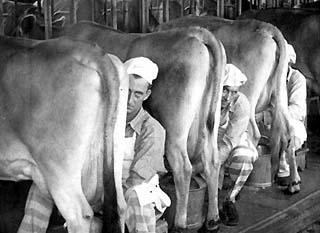1900
Florida's 778 state convicts live in 13 camps. Seven of these camps mine phosphate and six manufacture naval stores such as turpentine.
1902
INMATE POPULATION: 1,033
The Naval Stores & Commission Company wins the bid to lease convicts at $150 per annum. They begin taking photographs, measurements and noting marks for inmate identification.
The annual report for 1902 includes an expenditure of $4,000 for bloodhounds.
"CONVICTS" IN 1902 |
|
| Convicts on hand January 1, 1902 | 921 |
| Convicts committed during year | 449 |
| Convicts recaptured during year | 38 |
| Total: 1,408 | |
| Convicts discharged by expiration of sentence | 226 |
| Convicts escaped during year | 78 |
| Convicts pardoned during year | 40 |
| Convicts died during year | 23 |
| Convicts committed to asylum during year | 6 |
| Convicts discharged by order of court during year | 2 |
| Convicts on hand December 31, 1902 | 1,033 |
| Total: 1,408 | |
| Source: Reports of Commissioner of Agriculture 1889-1904 | |
1903
"Marion Farms" near Ocala is purchased as the location for a new central prison hospital for aging, crippled and infirm inmates.
PRISON LABOR
State prisoners are worked under the present lease on turpentine farms and phosphate mining. About 300 in the latter line of work, and 800 in the former. Both the turpentine and phosphate work is in the open air, as there is no tunnel or dark underground work such as there is in coal or iron mines in other States. The sunlight and air are never shut out.
Source: The Eighth Biennial Report of the Commissioner of Agriculture, January 1, 1903 - December 31, 1904. Letter from N.A. Blitch, Supervisor of State Convicts to Agriculture Commissioner B.E. McLin.
1905
"In the camps where buildings were constructed from wood, fires were not unusual. In October 1905, a fire at the Aycock Lumber Co., 10 miles southeast of Chipley in Jackson County, claimed the lives of nine men. These men were shackled together as they slept and were unable to free themselves when the blaze broke out. A few leaped from windows, then dangled from their chains as they burned to death. An investigation proved the guards were drunk and not on duty. The fire was set to cover two murders. The Aycock Lumber Co. was not permitted to lease convicts again for several years." Panama City News Herald, June 24, 2001.
According to an article by Marlene Womack in the Panama City News Herald dated April 5, 1998, there remains some controversy about who was responsible for setting the fire that night.
AYCOCK NAVAL STORES ROAD CAMP FIRE KILLS NINE
"The stockade at the Aycock Naval Stores Camp burst into flames the evening of Oct. 7, 1905. The camp was located in the logging woods about 10 miles southeast of Chipley but across the Jackson County line. All told, nine men died in the fire.
Some who remembered the tragedy told of hearing the way the chained men hung from the window and begged witnesses to cut off their feet or legs so they could be free before being burned alive. Others told of jeering, drunken guards and trustees who taunted victims and ignored their pleas for help.
According to the Pensacola Journal of Oct. 10, 1905, J.F. Longino was scheduled to work as the regular guard that night. But his brother, J.T. Longino, one of the day guards, pulled the duty while J.F. slept in the stockade's side room.
The fire broke out a little after midnight while J.T. was at the well, a short distance away. As he returned, he saw the blaze and began running toward the burning building. By the time he arrived at the scene, the flames had gained such headway it was impossible for him to release the chain fastened to the prisoners. With the help of the trustees he did succeed in rescuing six from the burning stockade. J.F. Longino, who slept inside, was one of the casualties.
After the fire, Dr. J.S. McGeachy of Chipley cared for the burned victims along with J.O. Kinol, the company's doctor. Stephen Spotes, one of the trustees, blamed the fire on a lamp that exploded. He said he awoke to find the walls around him on fire. He screamed to the other trustee. Together they broke down the door and window. Once the window was open, the chained prisoners crawled out the small opening then hung by their feet until the guard succeeded in cutting some free. Others burned to death in the inferno.
After the horrific blaze, no real investigation was made as to the fire's cause. A coroner's jury did not investigate the scene with the assumption being that an accidental explosion of a lamp ignited the building. But Chipley detective T.J. Watts took it upon himself to determine the real reason for the fire after he heard some rumors. In a letter to Gov. N.B. Broward, dated Oct. 23, 1905, Watts reported that "the guard and one convict were murdered by Jim Glassco, a free black laborer. The motive was robbery. J.F. Longino had $48.10 on his person, the convict $5. Glassco killed both men by crushing their skulls with a railroad spike maul. He torched the stockade to make it look like the fire caused the death of the men."
Sam Jones, a trustee at the camp, became the principal witness for the state. Jones testified that he saw Glassco enter the guard room immediately before the fire, heard two heavy blows and saw the flames shoot up. Then he watched Glassco flee from the room and run out of the stockade. Watts believed Jones knew so much about the fire because he was an accessory to the crime. But he could not prove it, so he arrested Glassco and charged him with murder. He took Glassco to Marianna to await the action of the grand jury. The leaseholders received severe criticism for neglecting their prisoners' welfare and safety even though the fire was really set by a murderer intent on hiding the evidence. Little came of the case, however.
Gov. Broward accepted carelessness and drunkenness on the part of the guard as the cause of what was described as "one of the most horrible crimes ever committed in the state." Aycock Lumber Co. was not permitted to lease convicts for several years.
As the naval stores industry grew in this section of Northwest Florida, increasing numbers of convicts were leased from the state. By 1910, stockades existed at places like Donaldson Point in Parker, Oliver Creek near Cook Bayou, Tompkins on the west side of what is today Deer Point Lake and several other locations. Prisoners turpentined the pine trees in the surrounding woods."
1913
Florida's State Prison Farm, the state's oldest and largest correctional institution, is erected on an 18,000-acre tract purchased for $5 an acre. The first buildings house infirm inmates who could not be leased to private businesses. It is named Raiford State Penitentiary but also referred to as the "State Prison Farm," "Raiford Prison" and "Florida State Prison."
Over the years this facility will be expanded to include many units and eventually split into two of the five prisons currently at Raiford (in 1972). These are: Union C.I.--the original Raiford State Penitentiary (whose main housing unit is later nicknamed "The Rock" because it was "built solid as a rock") and Florida State Prison--the "east unit" that opens in 1961.

State Farm convicts at work. (Photo courtesy of FPC.)
- 1821-1845
- 1868-1876
- 1877-1895
- 1900-1919
- 1921
- 1922-1924
- 1927
- 1928-1931
- 1932 | CHAPMAN
- 1933-1935
- 1936-1939
- 1940-1945
- 1946-1949
- 1950-1955
- 1956-1961
- 1962 | WAINWRIGHT
- 1963-1965
- 1966-1969
- 1970-1975
- 1976-1979
- 1980-1986
- 1987 | DUGGER
- 1988-1990
- 1991 | SINGLETARY
- 1992-1995
- 1996-1998
- 1999 | MOORE
- 2000-2002
- 2003 | CROSBY
- 2004-2005
- 2006 | MCDONOUGH
- 2007
- 2008 | MCNEIL
- 2009-2010
- 2011 | BUSS
- 2011 | TUCKER
- 2012 | CREWS
- 2013-2014
- 2014 | JONES
- 2015-2018
- 2019 | INCH
- 2020-2021
- 2021 | DIXON
- 2022-Today
- Population Summary Table

